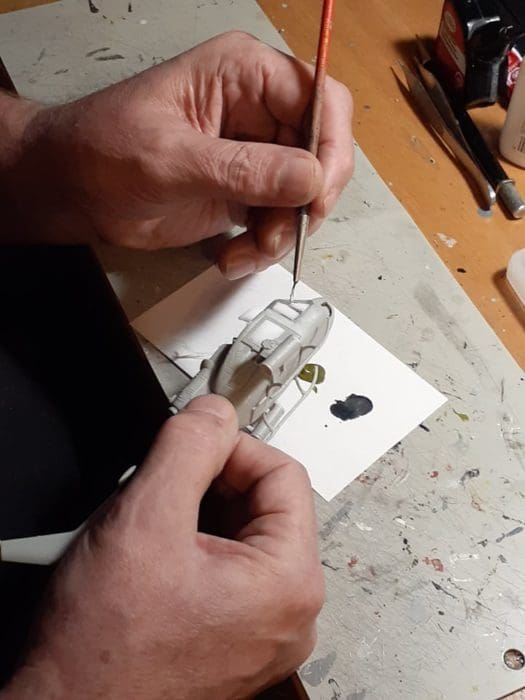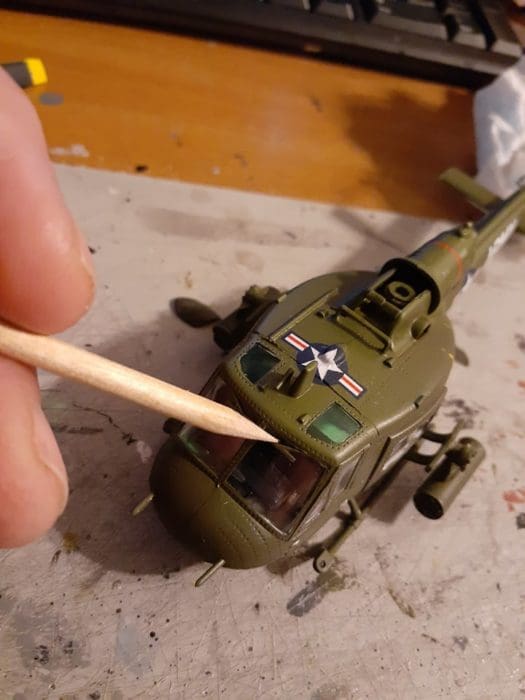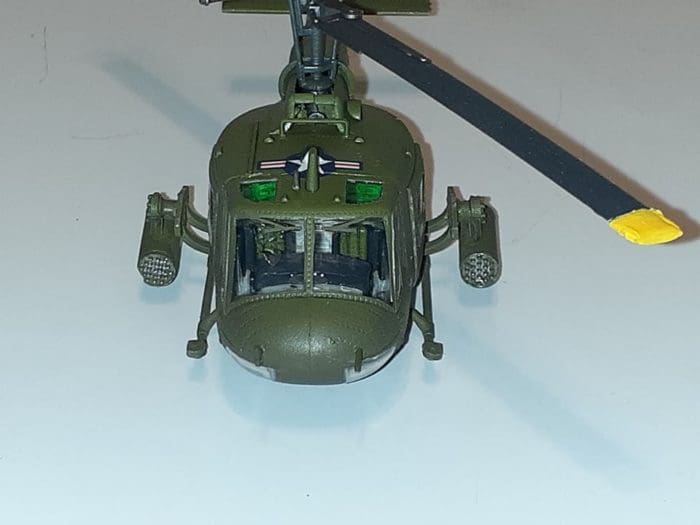By all accounts, this next build is one of the easiest I’ve done in the last couple of years. With the coming of a new year, I decided to get into doing some helicopters. For me, helicopters have always been a keen interest in how they work. The kit I selected I choose because it was one of the first that the US Army used in warfare, and it changed how we fought in Vietnam, and in subsequent wars.
The kit contained four gray sprues and one clear, plus decals. All of the parts were very crisp, the clear parts included the complete front “bubble” as most Huey kits do. This version did not have opening front doors as some other UH-1 kits do, but the side doors allow optional positioning.
Building
The first few steps built the interior. There are very accurate representations of the cyclic and collective controls and the seats have additional side armor for pilot protection. The panel is flat, and there is no decal for the instruments. That’s not a big deal as the panel is not really that visible from outside the finished model. There are a couple of interior options: a seat, a large ammo box, or a cylinder-shaped ammo container. For my project, I choose the square ammo box, more on that later. The entire interior is light gray, the pilot seats are black-gray and the panel and top of the instrument console are black. The main rotor mount/engine can scarcely be seen, for my project, I choose to be able to remove the rotor for transportation and storage, so I made a modification I’ll get to later.
The fuselage halves go went together very snugly, there was no real gap between the halves. The upper cowling is also a split piece and went together well. Pay attention when you install it onto the top of the fuselage though, I found it a bit fiddly getting it flush. From there the horizontal stabilizers and skids were installed so the model would sit correctly. I did counterbalance mine but in discussing this build with another modeler I was told it didn’t need to be. If you do choose to the area between the two small parts below the instrument panel is a good place to throw a few grams of lead. Just wait to install the panel until the fuselage halves are joined.
There are a few different weapons options. You can go “Full Hog” with the M3 box rocket launcher and a nose-mounted grenade launcher, or you can use the 2.75” FFR LAU-3 pods, or you can use the small miniguns as I had intended. Be aware: there are no ammo feed chutes for the miniguns, so if you are going to use them be prepared to fabricate the ammo feed chutes. Since I had intended to use the guns myself (by installing the square ammo box in the interior) I was disappointed they were absent. So I went with the LAU-3 pods instead. All of the weapons are very well-detailed.
Masking and Painting
In getting ready for painting I decided to use a 40+-year-old tip for masking my canopy glass. There are a number of great liquid masks available but I have used just ordinary white Elmers type glue as a mask. It’s nice and thick but can be thinned out with water if you wish. I tend to apply 2 coats and when it’s nearly clear it is dry. I shot my Huey with Vallejo Acrylic Olive Drab FS34088, and then lightly fogged the upper surfaces with Vallejo Acrylic US Light Green FS34151, just for a faded weathering look. There is a very subtle blend line but enough to change the hue of the fuselage. When all the base colors were dry I shot the model with 2 coats of Future wax to ready for decals. For my version, I chose the Medical Detachment decals but I omitted the Red Cross insignia on the doors. I was wanting just an armed scout helicopter, not a Medivac ship. I did have to use some Microsol and Microset, especially on the upper national insignia to get the decal to conform. When the decals were dry I resealed them with another coat of wax.
The time came to remove my white glue masking. I started by carefully scoring the margins with an X-Acto knife, then lifting the edge of the mask with the point. It came off cleanly and easily….as it has for the last 40 years. I had to go back and hand paint the wipers and got a little acrylic paint on the glass. That was rubbed off with a wooden cuticle stick without marring the plastic. Another great tip I learned 40 years ago.
The main and tail rotors were painted with a mix of metallics and a gray-black, then washed with a metallic black. I weathered the leading edges a bit with silver enamel. All of the swash plates and control rods were painted using Vallejo Acrylic Oily Steel and Gunmetal. I used the kit decals for the ends of the rotors. Other chipping was applied using Testors silver enamel with a dry-brushing technique.
Finished Model
The finished product was something I was happy with other than the disappointment over the feed belts for the miniguns. I like this period of subject as well, as helicopters were just starting to change the way that the United States fought wars. I hope you enjoyed this build review and thanks for stopping by.


























